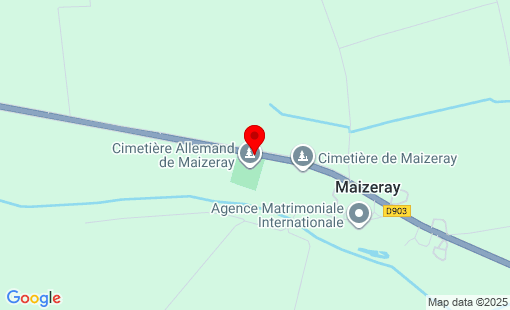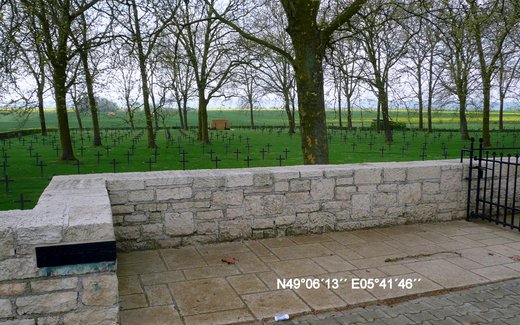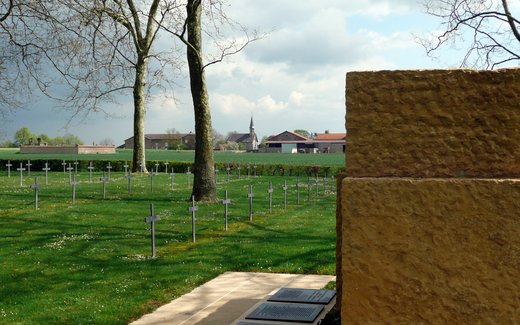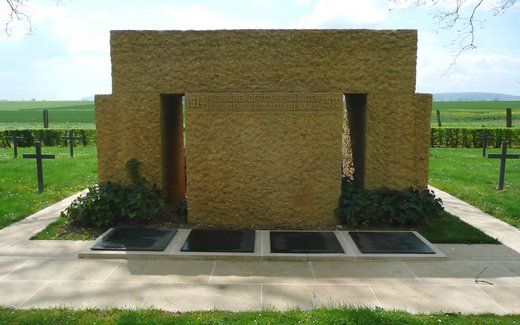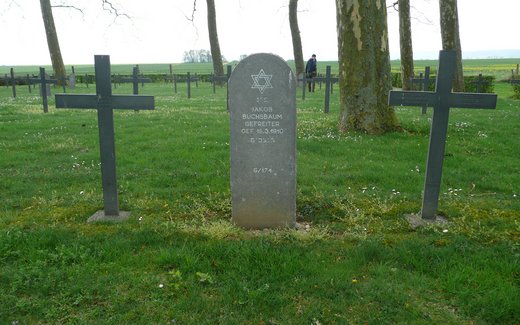Département Meuse; 2,876 German war dead, First World War
Among the dead are a nurse and three soldiers of the
k.u.k. Austro-Hungarian army. The German military cemetery at Maizeray was opened by the
by the French military authorities after the end of the Second World War as a
Cemetery for German soldiers who at that time were still scattered around
scattered in 60 surrounding communities and districts up to 20 kilometers away in temporary graves
Kilometers away in makeshift graves or were buried during
Found during recultivation work in the abandoned battlefields. The
The dead belonged to no fewer than 39 different infantry
no less than 39 different infantry divisions, most of them older soldiers
mainly older casualties who had served in 9 Landwehr Div
had done their service. The Austrian-Hungarian soldiers The Austrian-Hungarian soldiers served in the k.u.k. 35th Inf.
Div., which in the late summer of 1918 was sent to the Western Front with 3 other Inf
german army on the western front. The artilleryman had
already in action in the west since spring 1918.
The soldiers resting here belonged to units whose home garrisons were in the
Rhineland and Westphalia, but also those in Bavaria, Württemberg, Baden,
Saxony, Thuringia, West Prussia, Mecklenburg, Posen Silesia, Brandenburg,
Kurhessen and Berlin (Garde).
Repair work between the wars
The first work to improve the condition of the cemetery was carried out by the
Volksbund Deutsche Kriegsgräberfürsorge e.V. (German War Graves Commission) on the basis of an agreement reached with the
with the French military authorities in 1926. In the spring
already planted 258 plane trees. The communal grave received a natural stone border
of natural stone with a memorial stone. This was followed by the enclosure of the entire site with a fence
and hedge followed. However, the problem of permanently marking the
Graves remained unsolved due to a lack of foreign currency and the outbreak of the Second
World War broke out in 1939.
Final design
Following the conclusion of the Franco-German War Graves Agreement of July 19, 1966, the
1966, the Volksbund Deutsche Kriegsgräberfürsorge e.V. (German War Graves Commission) - financially
supported by the Federal Government - was able to finalize the design of the German
Cemeteries of the First World War in France. Volunteers
young volunteers from the War Graves Commission had already started the preparatory gardening work
work. in 1972, the previous provisional wooden
Wooden grave markers were replaced with metal crosses with the names and dates of those
those buried here. Prior to this, young helpers had laid the associated 35-kilogram
foundations, which were transported by the German Armed Forces, to the graves
Graves.
Of the 2,876 fallen, 2,367 rest in individual graves; one remains nameless. In
the common grave with 540 victims, 446 remained unnamed.
For religious reasons, the seven graves of the fallen of the Jewish faith were marked
Jewish graves were marked with a natural stone grave stele instead of a cross for religious reasons,
whose Hebrew characters read:
1. (above) "Here rests buried ... ."
2. (below) "May his soul be integrated into the circle of the living.
This was followed by a fundamental landscaping overhaul. Thus
a retaining wall with an entrance and stairs made of natural stone to the higher
Road was erected. At the same time, a parking lot was built.
This was followed by additional planting of trees, shrubs and hedges
as well as the greening of the grave area.
Maintenance:
The cemetery is constantly maintained by the Volksbund's maintenance service.
France
Maizeray
Total Occupation: 2.876 fatalities
Total Occupation: 2.876 fatalities
Contact
